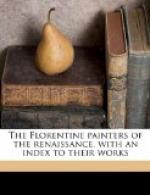[Page heading: ANTHROPOMORPHISM IN ART]
Michelangelo had a sense for the materially significant as great as Giotto’s or Masaccio’s, but he possessed means of rendering, inherited from Donatello, Pollaiuolo, Verrocchio and Leonardo,—means that had been undreamt of by Giotto or even by Masaccio. Add to this that he saw clearly what before him had been felt only dimly, that there was no other such instrument for conveying material significance as the human nude. This fact is as closely dependent on the general conditions of realising objects as tactile values are on the psychology of sight. We realise objects when we perfectly translate them into terms of our own states, our own feelings. So obviously true is this, that even the least poetically inclined among us, because we keenly realise the movement of a railway train, to take one example out of millions, speak of it as going or running, instead of rolling on its wheels, thus being no less guilty of anthropomorphising than the most unregenerate savages. Of this same fallacy we are guilty every time we think of anything whatsoever with the least warmth—we are lending this thing some human attributes. The more we endow it with human attributes, the less we merely know it, the more we realise it, the more does it approach the work of art. Now there is one and only one object in the visible universe which we need not anthropomorphise to realise—and that is man himself. His movements, his actions, are the only things we realise without any myth-making effort—directly. Hence, there is no visible object of such artistic possibilities as the human body; nothing with which we are so familiar; nothing, therefore, in which we so rapidly perceive changes; nothing, then, which if represented so as to be realised more quickly and vividly than in life, will produce its effect with such velocity and power, and so strongly confirm our sense of capacity for living.
[Page heading: VALUE OF THE NUDE IN ART]
Values of touch and movement, we remember, are the specifically artistic qualities in figure painting (at least, as practised by the Florentines), for it is through them chiefly that painting directly heightens life. Now while it remains true that tactile values can, as Giotto and Masaccio have forever established, be admirably rendered on the draped figure, yet drapery is a hindrance, and, at the best, only a way out of a difficulty, for we feel it masking the really significant, which is the form underneath. A mere painter, one who is satisfied to reproduce what everybody sees, and to paint for the fun of painting, will scarcely comprehend this feeling. His only significant is the obvious—in a figure, the face and the clothing, as in most of the portraits manufactured nowadays. The artist, even when compelled to paint draped figures, will force the drapery to render the nude, in other words the material significance of the human body. But how much more clearly will this significance shine out, how much more convincingly will the character manifest itself, when between its perfect rendering and the artist nothing intervenes! And this perfect rendering is to be accomplished with the nude only.




